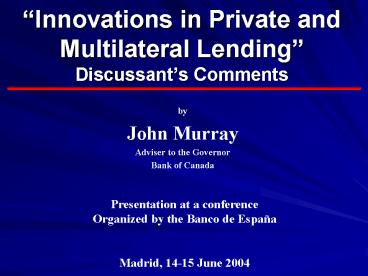- PowerPoint PPT Presentation
1 / 7
Title:
Description:
How much weight should be given to the standardization of bond covenants as opposed to tailoring ... Bankruptcy Arrangements for Sovereign Debt Workouts: An Idea ... – PowerPoint PPT presentation
Number of Views:35
Avg rating:3.0/5.0
Title:
1
Innovations in Private and Multilateral
LendingDiscussants Comments
- by
- John Murray
- Adviser to the Governor
- Bank of Canada
Presentation at a conference Organized by the
Banco de España Madrid, 14-15 June 2004
2
De-Dollarizing Multilateral Credit
Dollar, Debts and the IFIs De-Dollarizing
Multilateral Credit by Eduardo Levy-Yeyati
- Major recommendation IFIs could encourage the
development of deeper domestic capital markets in
EMEs (and promote de-dollarization) by extending
loans and raising capital in local currencies. - Prof. Yeyatis proposal is intriguing and
deserves serious consideration. Nevertheless, I
would like to play Devils advocate for a moment.
3
De-Dollarizing Multilateral Credit
Contd
- Some questions
- Would the proposal have much effect? If
de-dollarization were confined to offshore
markets, how much knock-on effect would it have
in the local market? Wouldnt this be a
self-contained system, much like the existing
dollarized situation? - Is there a risk that domestic funds would be
redirected? IFIs obligations might attract
savings that currently remain in the country.
Would this pose a problem? Could it subvert the
development of the domestic market?
4
De-Dollarizing Multilateral Credit
Contd
- How much interest will offshore investors have in
IFI securities? Prof. Yeyati assumes there is a
large untapped pool of interested investors, who
are not concerned with currency risk. Is this the
case? - Is dollarization everywhere and always a bad
thing? Can we assume that every country needs
an active local currency capital market? Do we
need to be more selective? Which countries might
be the most obvious candidates for
de-dollarization?
5
Optimal CAC Thresholds
Optimal Collective Action Clause Thresholds by
Adrian Penalver (co-authored with Andrew Haldane,
Victoria Saporta, and Hyun Song Shin)
- Major recommendation A strong theoretical case
can be made for allowing CAC thresholds to vary
among sovereign debtors, reflecting differences
in risk aversion and credit worthiness. - The authors have presented a thoughtful and
convincing analysis, which extends earlier work
in this area by recognizing the interaction
between solvency and liquidity crises.
6
Optimal CAC Thresholds
Contd
- Some questions
- Are creditors sensitive to differences in CAC
thresholds? Past experience and recent
empirical work seem to suggest that creditors are
often unaware of CACs, let alone differences in
their thresholds. (Richards and Gugiatti) - Is there a risk of reading too much into recent
events? Are Belize, Brazil and Guatemala
substantively different than Turkey and the
Philippines? Why have debtor preferences had so
little effect on the thresholds embedded in U.K.
bonds?
7
Optimal CAC Thresholds
Contd
- What are the policy implications of the analysis?
How much weight should be given to the
standardization of bond covenants as opposed to
tailoring them to debtors differing
circumstances? Has the G-10 been too
prescriptive? - Can the authors analysis be extended to other
CACs features? Is it possible to explain other
differences in the CACs using their model? Are
thresholds the only relevant degree of freedom?































